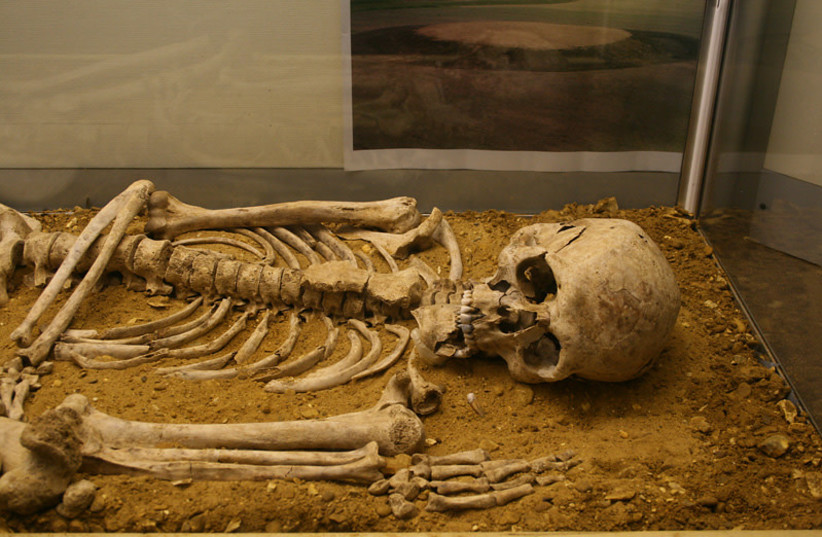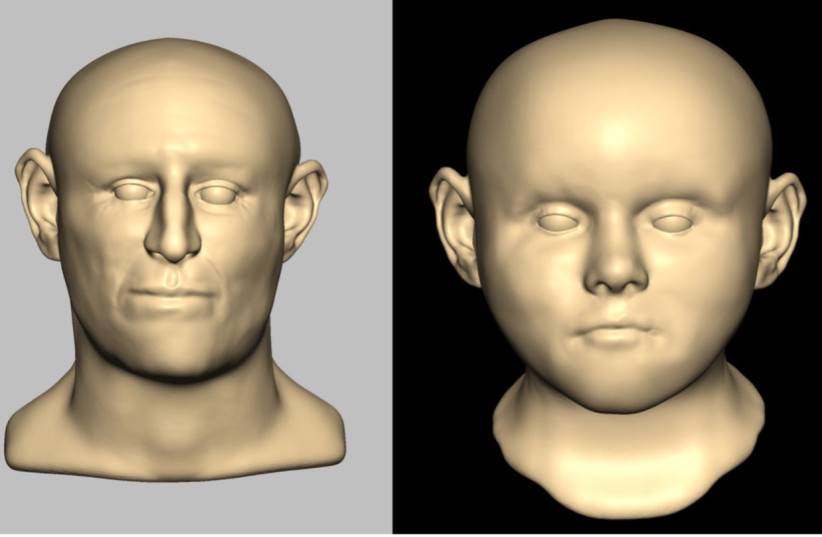 Skeleton examinations reveal 1000-year-old antisemitic violence – study
Skeleton examinations reveal 1000-year-old antisemitic violence – study
JUDY SIEGEL-ITZKOVICH
The position of the remains, their completeness and their conversion by archaeologists into cleaned and articulated skeletons suggested that they had all been buried at once shortly after death
.

(photo credit: David Pearson)
Genetic analysis of human skeletal remains in Norwich, England, found by construction workers preparing the site for a shopping center has provided serious evidence that the bones are those of at least 17 Ashkenazi Jews who were murdered during a proven historic episode of antisemitic violence on February 6, 1190.
The genomes from a medieval mass burial show that Ashkenazi-associated hereditary diseases pre-date the 12th century. The findings resulted from a revised radiocarbon analysis of the bones carried out by experts at London’s Natural History Museum, University College and Francis Crick Institute; the Institute of Organismic and Molecular Evolution in Mainz, Germany; the University of Cambridge; and the Archive Center in Norwich.
They have just been published in the journal Current Biology under the title “Genomes from a medieval mass burial show Ashkenazi-associated hereditary diseases pre-date the 12th century.”
In 2004, construction workers excavating land in central Norwich – about 160 kilometers northeast of London – as part of the Chapelfield shopping center development uncovered the bones.
The position of the remains, their completeness and their conversion by archaeologists into a cleaned and articulated skeleton suggested that they had all been buried in a single event shortly after their death.

The mass grave in a dry well, less than half a meter deep and one meter in diameter, contained the highly compacted remains of at least 17 people. The overrepresentation of youngsters and the unusual location of the burial outside of consecrated ground suggested that they may have been victims of a mass fatality event such as mass murder, the archaeologists wrote.
Ancient DNA from 25 bones was screened, and six individuals were selected for sequencing. “They represent the present-day population that we would expect to be genetically most similar to Jews in medieval England,” they wrote.
The researchers found that four of these individuals were closely related and six had strong genetic affinities with modern Ashkenazi Jews. Some had genes for red hair.
Pottery sherds that were also found in the well were dated to the 12th-14th centuries, and two initial radiocarbon analyses of the skeletal remains placed these in the 11th-12th centuries.
Sediment surrounding the remains comprised soils from outside the well, suggesting bodies had been rapidly buried by soil after they died.
Bone analysis results
BONE ANALYSIS identified at least six adults and 11 babies, toddlers and teens. The remains comprised at least one adolescent, two 10-to-15-year-olds, three five- to-10-year-olds, three toddlers aged three to five and babies aged 0 to three years.
The adult remains included both males and females. This overrepresentation of children and teens, they wrote, “suggests a catastrophic profile, where people of all ages had a similar risk of death, and the compaction of the remains suggested that they had been deposited in a single event.”
Simulations indicate that Ashkenazi-associated genetic disease alleles (one of two or more versions of a DNA sequence at a given genomic locations). “These findings provide new insights into a significant historical crime, into Ashkenazi population history and into the origins of genetic diseases associated with modern Jewish populations,” wrote authors Selina Brace, Yoan Diekmann, Thomas Booth, Ruairidh Macleod, Adrian Timpson, Will Stephen , Giles Emery, Sophie Cabot , Mark G. Thomas and Ian Barnes.
The proven historical event in Norwich within this date range was in 1190, when members of the Jewish community were murdered during antisemitic riots precipitated by the beginning of the Third Crusade. Norwich had been the setting for a previous notable event in the history of medieval antisemitism when, in 1144 CE, the family of William of Norwich claimed that local Jews were responsible for his murder – an argument taken up by Thomas of Monmouth through the first documented invocation of the blood-libel myth. “This represents the beginnings of an antisemitic conspiracy theory that persists up to the present day,” they wrote.
“The possibility that the remains found at the Chapelfield well site were those of the victims of antisemitic violence is given further support by the site’s location just to the south of the medieval Jewish quarter of the city,” they continued.
Ashkenazi ancestry
After the destruction of the Second Temple in 70 CE Ashkenazi communities were formed in Northern Europe during the medieval period. They were targeted for antisemitic persecution arising from the Crusades and baseless reprisals for allegedly spreading the Black Death.
Present-day Ashkenazim are descendants of medieval Jewish populations with histories primarily in northern and eastern Europe who hardly married non-Jews or non-Ashkenazim.
As a result, they carry distinctive ancestries. Hereditary disorders in Ashkenazi Jewish populations have been the focus of considerable medical research, with genetic screening now commonplace to reduce risks, including genetically transmitted breast cancer.
No genomes from known Jews had been available from the medieval period or earlier, they wrote, “largely because exhumation and scientific testing of Jewish remains is prohibited. Such data could inform on the migration and admixture histories of Jewish populations. Furthermore, the presence of any pathogenic variants would provide valuable clues to the origins and spread of Ashkenazim associated genetic disorders.”
In addition, historical sources indicate that the Norwich Jewish community descended from Ashkenazi Jews in France who came to England from Rouen, Normandy, at the invitation of William the Conqueror after 1066.
Patterns of skeletal articulation and completeness indicated that the skeletons were originally interred as complete, intact bodies, with little to no delay between their death and deposition. The Chapelfield burials, they wrote, thus appear to represent a catastrophic mortality.
“In some cases, the bones of the legs were higher up in the sediment than the skulls from the same skeletons, suggesting bodies had been deposited in the well head first.”
There were no signs of trauma beyond broken ribs that could have been produced when the bodies hit the bottom of the well, although it’s possible they had been intentionally killed by a method that left no signs of trauma on the bones, the authors suggested.
“There were no signs of skeletal trauma of a type commonly found in individuals who attempted to break a fall, providing some indication that the people had died before their bodies were deposited in the well.”
Zawartość publikowanych artykułów i materiałów nie reprezentuje poglądów ani opinii Reunion’68,
ani też webmastera Blogu Reunion’68, chyba ze jest to wyraźnie zaznaczone.
Twoje uwagi, linki, własne artykuły lub wiadomości prześlij na adres:
webmaster@reunion68.com
